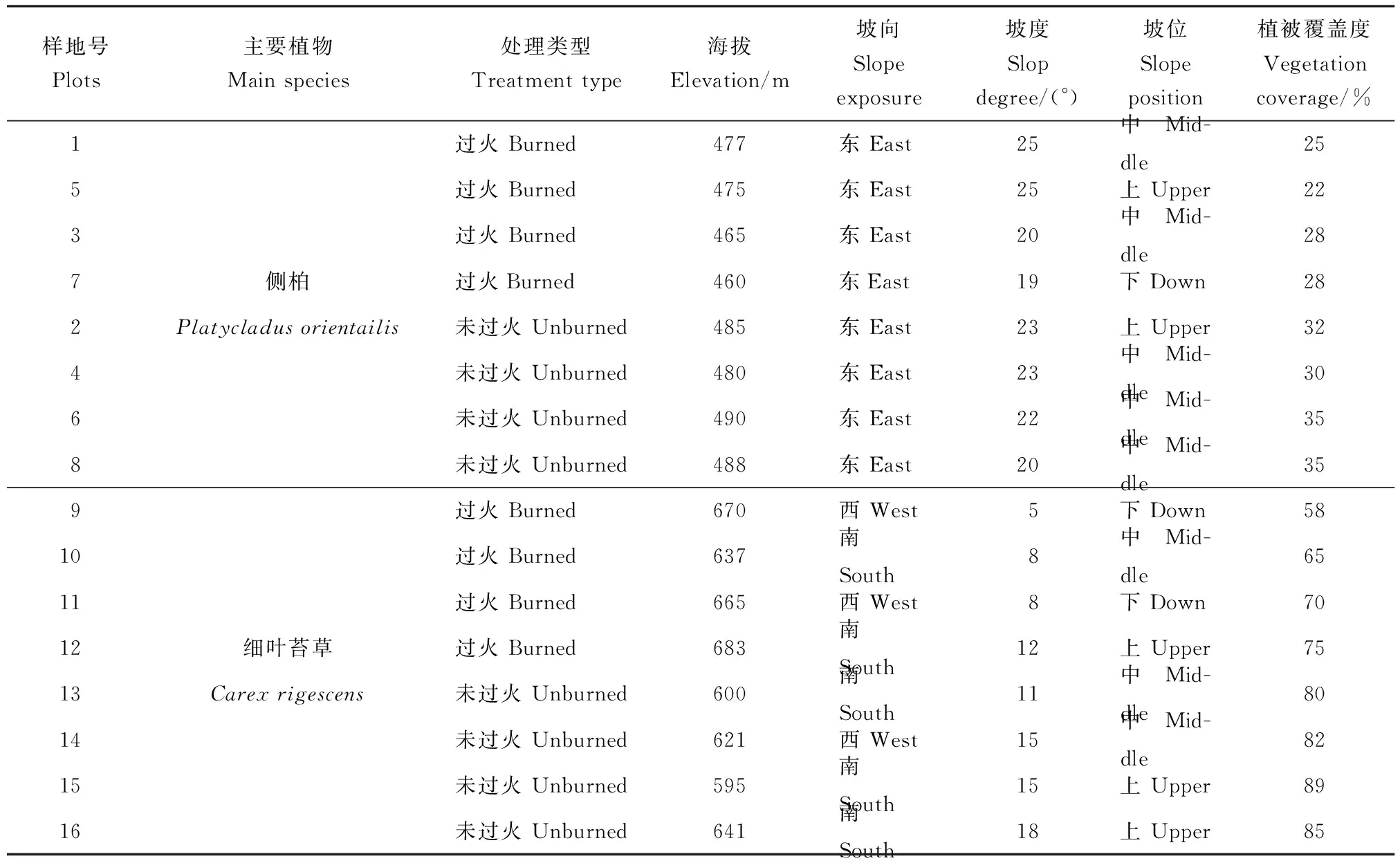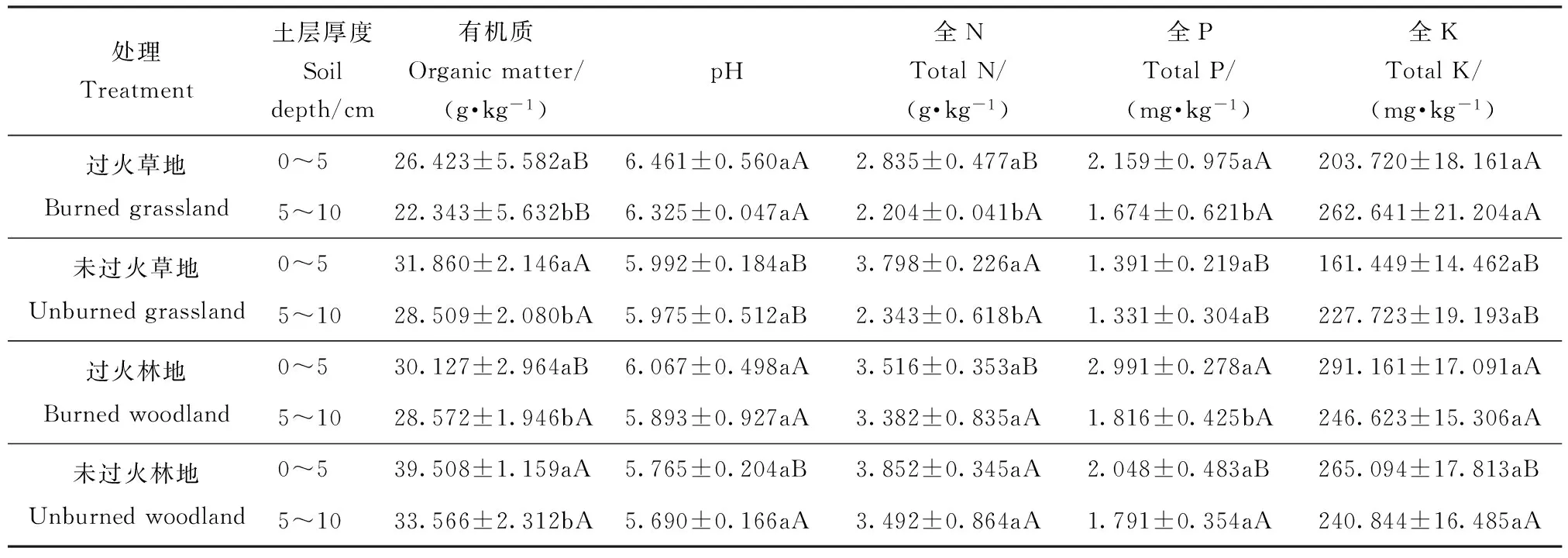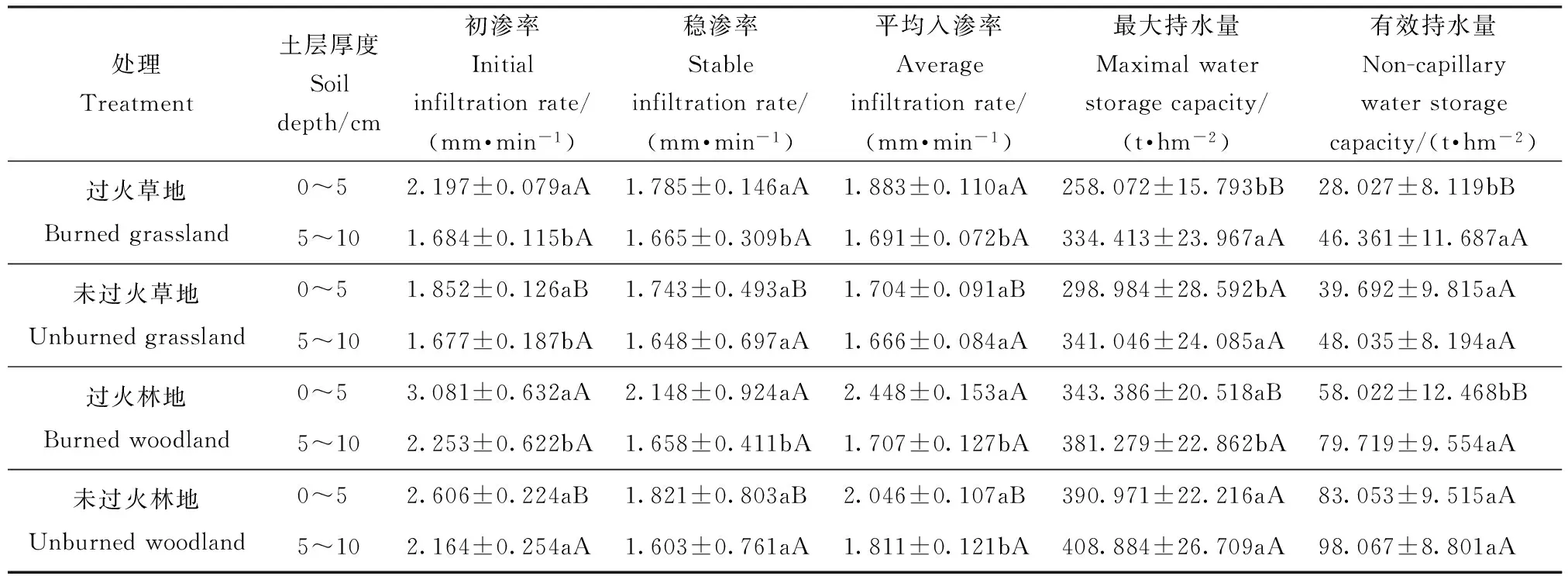中度火干扰对林草地土壤理化特性的短期影响
闫东锋,吴桂藏,郭丹丹,张振,杨喜田
(河南农业大学林学院,450002,郑州)
中度火干扰对林草地土壤理化特性的短期影响
闫东锋,吴桂藏,郭丹丹,张振,杨喜田
(河南农业大学林学院,450002,郑州)
火干扰作为一种自然扰动现象,对土壤物理、化学、矿化和微生物等土壤性质产生一定影响。在河南具茨山国家级森林公园过火林地和草地,进行土壤样品 (0~5和5~10 cm土层) 采集,测定表征土壤渗透性和持水能力的指标,研究中度火干扰对不同土层土壤理化特性的短期影响。结果表明:中度火干扰造成草地和林地土壤表层(0~5 cm)的土壤密度、含水率和非毛管孔隙度显著下降(P<0.05),但火烧前后,土壤5~10 cm层上述物理特性指标之间没有显著差异(P>0.05);火烧后草地和林地土壤表层(0~5 cm)有机C和全N显著下降(P<0.05),而土壤pH、全P和全K显著上升(P<0.05),相似的现象出现在草地土壤5~10 cm层,火烧前后林地土壤5~10 cm层,各化学特性指标没有显著差异(P>0.05)。火烧使草地和林地土壤0~5 cm层的土壤初渗率、稳渗率和平均入渗率均显著上升(P<0.05),而对土壤5~10 cm层土壤各渗透特性指标没有显著影响(P>0.05);火烧使草地和林地土壤0~5 cm层土壤最大持水量和有效持水量均显著下降(P<0.05),草地和林地最大持水量分别从未过火289.984和390.971 t/hm2,下降到258.072和342.386 t/hm2。该研究为开展火烧迹地植被恢复、水土保持和森林经营管理措施的制定,提供科学依据。
草地; 林地; 土壤入渗; 土壤持水能力; 土壤化学; 具茨山; 河南
林火作为一种常见的自然现象,深刻影响着许多生态过程,尤其是森林生态系统发育过程[1]。火烧在改变植被恢复进程的同时,还会深刻改变土壤物理、化学和微生物发育进程,火烧对土壤影响程度的强弱,也会受到火烧烈度[2]、土壤类型[3]、植被特征[4]、火烧后气象因素[5]和土壤本身性质等诸多因素的影响。研究表明,低强度的火烧对土壤理化特性的影响有限,而高强度的火烧会对土壤性质产生负面影响[6],如土壤有机质的流失[7],微生物数量下降和种类减少[8],土壤结构稳定性下降[9],土壤侵蚀和流失上升[10]等。土壤入渗是水分通过地表进入土壤的过程[11],影响着水分传输的再分配能力、地表径流和土壤侵蚀量[12];土壤持水能力是衡量土壤水源涵养功能和水土保持功能的重要指标[13]。由于林火会改变土壤结构,造成结构稳定性下降,进而可能会影响土壤渗透和持水能力;但是这种影响在不同的火烧烈度和土壤类型之间,也可能存在着一定的差异。
目前,关于火烧对土壤性质的影响研究,集中在土壤有机C、N及其循环[14-15]、土壤有机质[16]等土壤化学性质、植被,以及土壤斥水性[17]、土壤侵蚀[12]和土壤微生物[18]等方面,而且由于生态过程的复杂性,研究结论往往并不一致。中等强度火干扰,对土壤诸多理化性质和生态过程影响的研究相对较少[14],尤其是对土壤渗透特性的研究未见报道,火烧前后土壤渗透和持水能力的变化,尚不清楚。笔者以具茨山林地和草地火烧迹地为研究对象,通过开展野外土壤调查和室内实验,研究火烧前后土壤理化性质、土壤渗透特性和土壤持水能力的变化,旨在为开展科学的林火管理和植被恢复实践提供参考。
1 研究区概况
研究区具茨山国家级森林公园位于河南省新郑市西南部(E 113°32′,N 34°21′),与禹州市和新密市接壤。该区属伏牛山余脉,面积3 km2,海拔793 m,处于暖温带半湿润半干旱地区,多年平均气温为14.15 ℃。海拔较高地带以草丛地为主,其他区域以落叶阔叶林地为主,以及部分常绿阔叶林和针阔混交林地。乔木建群种以黑松(Pinusthunbergii)、栓皮栎(Quercusvariabilis)和侧柏(Platycladusorientalis)为主。该区地处风口区,人为活动十分频繁,近年来多次发生强度不大的森林火灾。
2 材料与方法
2.1 样地设置和样品采集
2011年10月,研究区发生了一次过火面积较大的森林火灾,林木死亡株树占总株树的35%。根据火烧烈度的分级标准[19],判定此次火灾为中度火干扰。与草地相比,过火及未过火林地坡度较大,立地条件较差,地被物覆盖度和生物量较低,主要树种侧柏采用鱼鳞坑方法栽植,平均树高为3 m。2013年春季,在火烧迹地全面踏查的基础上,对林地和草地选择火烧后土壤和植被环境条件相似的地块,开展野外土壤调查。分别选取面积为10 m×10 m过火草地样地和20 m×20 m过火林地样地各4个;同时,在过火样地附近,选择环境条件基本一致、数量相同的未过火样地作为对照,样地基本情况见表1。

表1 样地基本情况表Tab.1 Basic conditions of plots
土壤调查是在样地4角及中心选取5个样点,挖土壤剖面,去除土壤表层植物、凋落物和腐殖质后,用小环刀(容积100 cm3,高5.1 cm)分别取地表土壤(0~5 cm)以及地表下层(5~10 cm)原状土样各2份,密封后带回实验室,分别进行土壤渗透性能和土壤水分物理特性的测定。将取样点各层土壤混合后,去除根系和石块,取约1 kg混合土样,装入布袋带回实验室自然风干,用于土壤化学元素的测定。
2.2 样品分析
土壤渗透特性测定采用双环入渗法[20-21]。具体过程如下:将含有原状土的环刀带回室内,浸水24 h(浸水深度4.9 cm)后,在其上部密封接合一个相同规格的空环刀,并固定于漏斗架上,向上部空环刀内注水,并保持4~5 cm水层高度,自滴下第1滴水开始计时,以后每隔3、5、10和15 min更换烧杯,并计量渗下的水量,试验持续到稳定入渗时为止,每更换一次烧杯,要将上面环刀水面加至原来高度。
根据单位时间渗透量,计算土壤初渗率(mm/min)、稳渗率(mm/min)和平均入渗率(mm/min)。土壤初渗率为前6 min土壤平均入渗速率,稳渗率为土壤入渗达到稳定时的土壤入渗速率,平均入渗率为从入渗开始到稳渗时的平均入渗速率。土壤持水能力采用土壤最大持水量和土壤有效持水量表征[23]。
Wt=10 000Pth。
式中:Wt为土壤最大持水量,t/hm2;Pt为总孔隙度,%;h为土层厚度,m。
Wa=10 000Pah。
式中:Wa为土壤有效持水量,t/hm2;Pa为非毛管孔隙度,%。
土壤物理和化学性质测定方法[22]如下:采用环刀法分别测定土壤密度、毛管孔隙度、非毛管孔隙度和总孔隙度;土壤含水率采用烘干法;土壤有机C采用高温外加热重铬酸钾氧化- 容量法;土壤全N采用硫酸- 过氧化氢凯氏定氮仪蒸馏滴定法;土壤pH值采用电位法测定;土壤全P采用酸溶- 钼锑抗比色法;土壤全K的测定采用全钾采用火焰原子吸收分光光度法。
2.3 数据处理
采用R软件(https:∥cran.r-project.org/mirrors/,R version 3.3.1)平台,对林地和草地分别进行统计分析。利用t.test函数,分别对相同土层厚度、不同处理(过火及未过火),以及相同处理、不同土层厚度(0~5和5~10 cm)之间的土壤理化性质指标,分别采用t检验,进行差异的显著性检验。
3 结果与分析
3.1 中度火干扰对土壤理化特性的影响
火烧对土壤密度、土壤孔隙度和土壤含水率均造成了显著影响(表2),但是火烧后林地和草地,不同土层、不同土壤理化特征指标变化趋势并不一致。火烧均使林地和草地土壤表层(0~5 cm)土壤密度、土壤含水率和非毛管孔隙度显著下降(P<0.05),火烧前后5~10 cm土壤上述指标没有显著差异(P>0.05)。说明火烧改变了土壤物理性质,但是这种改变主要集中在土壤表层;这是因为火烧时,土壤温度随土层厚度增加快速下降,对土壤物理性质的影响有限。从火烧对表层(0~5 cm)土壤影响程度来看,火烧对林地土壤密度的影响(下降11.295%)大于对草地的影响(下降3.994%),对其他指标的影响差别不大。

表2 火干扰后林地、草地土壤物理性质的变化(平均值±标准差)Tab.2 Changes of soil physical properties of woodland and grassland after fire disturbance (Mean±SD)
注:同列数据标不同小写字母表示林地或草地相同处理、不同土层厚度各指标数值差异显著;同列数据标不同大写字母表示林地或草地相同土层厚度、不同处理火烧前后各指标数值差异显著;P<0.05;下同。Note:Different small letters in the same column indicate the significant difference among index values between different soil depths in the same treatment of woodland or grassland.Different capital letters in the same column indicate the significant difference among index values between burned treatment and unburned treatment in the same soil depth of woodland or grassland.(P<0.05).The same below.
林地、草地火烧前后,土壤化学性质均发生不同程度的变化(表3)。与火烧对土壤物理性质的影响规律相似,火烧对林地土壤化学性质的显著影响主要表现在土壤表层(0~5 cm),林地土壤表层有机C和全N均显著下降(P<0.05),土壤pH、全P和全K均显著上升(P<0.05),而火烧对林地下层土壤(5~10 cm)没有显著的影响。火烧使草地土壤表层(0~5 cm)有机C和全N均显著下降(P<0.05),而土壤pH、全P和全K均显著上升(P<0.05),且火烧除了对草地下层土壤(5~10 cm)全N没有显著影响外,对其他土壤化学性质指标的影响与土壤表层(0~5 cm)相同,即产生了显著的影响。说明火烧对草地土壤0~10 cm层土壤主要化学性质指标,均造成了显著影响,而对林地的影响主要集中在0~5 cm土层。
上述结果可能与研究区特殊的植被特征有关,即林地和草地地表可燃物生物量存在显著差异,对照草地平均地被物覆盖度为81%,而对照林地平均地被物覆盖度只有33%(表1)。据调查,对照草地可燃物的生物量(1.356 t/hm2)显著高于对照林地(0.872 t/hm2)(P<0.05),且过火林分为密度不大的侧柏幼龄林(平均树高3 m),对林火燃烧的助推作用有限;因此,与林地相比,草地火烧持续时间长,可能会对表层土壤产生较为持久的影响。

表3 火干扰后林地、草地土壤化学性质的变化(平均值±标准差)Tab.3 Changes of soil chemical properties of woodland and grassland after fire disturbance (Mean±SD)
3.2 中度火干扰对土壤渗透特性的影响
火烧前后,从草地和林地土壤表层(0~5和5~10 cm)的初渗率、稳渗率和平均入渗率(表4)可知,草地和林地各土壤渗透特性指标在不同土层之间呈现相同的趋势,即火烧造成了土壤0~5 cm层土壤初渗率、稳渗率和平均入渗率显著上升(P<0.05),如草地和林地平均入渗率分别从未过火的1.704和2.046 mm/min上升到1.883和2.448 mm/min,分别增加9.506%和16.422%,而火烧对土壤5~10 cm层土壤各渗透特性指标没有显著的影响(P>0.05)。说明与火干扰对土壤密度、含水率和土壤空隙特性的影响类似,火干扰对土壤渗透特性的影响,也主要集中在土壤0~5 cm土层。

表4 火干扰后林地、草地土壤渗透特性和持水能力的变化(平均值±标准差)Tab.4 Changes of soil infiltration properties and water storage capacities of woodland and grassland after fire disturbance (Mean±SD)
3.3 中度火干扰对土壤持水能力的影响
火烧对土壤持水能力的影响,与对土壤渗透特性的影响基本一致,即火烧对土壤持水能力的影响,主要体现在土壤表层(0~5 cm),而对土壤5~10 cm层的影响不明显。火烧造成土壤0~5 cm层土壤最大持水量和有效持水量显著下降(P<0.05),草地和林地最大持水量分别从未过火的289.984和390.971 t/hm2下降到258.072和342.386 t/hm2,分别下降25.830%和24.625%。由于火烧,使得土壤孔隙度下降,进而造成土壤持水能力的下降,不利于水土保持和水源涵养功能的发挥。
4 讨论
火干扰不仅改变植被恢复的进程,还会影响土壤水分渗透和地表径流过程,进而可能造成土壤侵蚀、退化和营养元素流失等现象的发生[22]。火烧对土壤的影响,往往在短时间内表现的最为剧烈[14]。很多学者都选择土壤表层开展研究工作,如E.L.Thomaz 等[8]选择0~2.5和2.5~5 cm土层,开展火烧对土壤特性的影响研究。笔者选择一个中度火烧水平的林火,重点研究火干扰对土壤特性的短期影响,且主要选取土壤0~10 cm层开展研究。其结果也证明,火烧对土壤的影响主要体现在土壤表层,发现火烧后,土壤表层(0~5 cm)土壤密度、含水率、非毛管孔隙度、总孔隙度、土壤渗透特性指标和土壤持水特性指标,均发生显著变化,但火烧前后土壤5~10 cm层,上述土壤特性指标并没有发生显著变化。这主要是因为随着土层厚度的增加,火烧造成土壤温度上升的趋势会迅速改变[23],特别是土壤较湿润的地区,火烧对土壤下层土壤的影响非常有限。火烧对土壤的影响会受很多因素的影响,研究发现火烧后,草地和林地土壤表层含水率和孔隙度显著下降(P<0.05)。这与耿玉清等[24]关于北京西山油松林火烧后,土壤物理性质的研究结果一致;但是与唐季林等[25]对云南松林火烧前后,土壤性质的对比研究却明显不同,云南松林土壤火烧后,土壤总孔隙度却在升高。笔者还发现火烧后,土壤密度显著下降,这与唐季林等[25]的研究结果一致,却与耿玉清等[24]的研究结果不同。
国内外的相关研究结果[26-27]表明,火烧后土壤pH值一般呈上升趋势,尤其是在高温调节下(>450~500 ℃),这与笔者研究结果一致,主要原因可能是可燃物燃烧产生大量的CaCO3,CaCO3溶入水后,使得土壤呈弱碱性,造成pH值上升[28]。火烧对土壤的一个重要影响就是造成土壤有机C的流失,且有机C的恢复,需要在火烧迹地自然或人工植被恢复之后才开始。笔者发现火烧后,土壤有机C显著下降。这与大多数的研究结果一致,如闫平等[29]对大兴安岭兴安落叶松的研究等;但与H.A.Syman[5]的研究结论截然相反。土壤N在火烧后,极易挥发,但是低强度的火烧可能对N素的影响不大,土壤全N在火烧后迅速下降,这与耿玉清等[25]的研究结果一致。
火烧后,草地和林地土壤表层的土壤初渗率、稳渗率和平均入渗率等土壤渗透特性指标,均呈显著上升趋势,这与J.Neris等[30]研究结果一致;火烧还造成了草地和林地土壤0~5 cm层土壤最大持水量和有效持水量显著下降。现有研究[31]表明,火烧深刻影响着土壤有机C、结构稳定性和土壤密度,这些都会对土壤渗透和持水能力产生影响。笔者只进行了一次取样,目的在于分析火烧前后土壤理化性质的变化趋势,而没有对火烧迹地开展连续取样,且分析指标有限;因此,无法准确描述火烧后土壤理化性质变化进程及其影响因素,也是以后研究中需要改进的地方。
5 结论
1)中度火干扰对土壤理化性质的影响,主要集中在土壤表层(0~5 cm),使土壤表层土壤密度、含水率、非毛管孔隙度、有机C和全N显著下降(P<0.05),而土壤pH、全P和全K均显著上升(P<0.05),说明火干扰对土壤理化性质产生显著影响,可能会对火烧后植被恢复进程和水文过程产生影响。
2)火烧后,草地和林地土壤0~5 cm层土壤初渗率、稳渗率和平均入渗率呈显著上升(P<0.05)趋势,而火烧对土壤5~10 cm层土壤各渗透特性指标,没有显著的影响(P>0.05);火烧造成草地和林地0~5 cm层土壤最大持水量和有效持水量显著下降(P<0.05),而对土壤5~10 cm 层土壤最大持水量和有效持水量影响不明显。在开展火烧迹地土壤水文研究或制订水土流失防治措施时,应把土壤表层作为研究重点;同时,应该考虑火烧造成有机C和全N下降以及pH上升等趋势,可能对植被恢复进程产生的影响。
[1] CERTINI G.Effects of fire on properties of forest soils:a review [J].Oecologia,2005,143(1):1.
[2] 谷会岩,金靖博,陈祥伟,等.不同火烧强度林火对大兴安岭北坡兴安落叶松林土壤化学性质的长期影响 [J].自然资源学报,2010,25(7):1114.GU Huiyan,JIN Jingbo,CHEN Xiangwei,et al.The long-term impacts on chemical properties ofLarixgmeliniforest on the northern slope of Greater Hinggan Mountains from a forest fire of varying fire intensity [J].Journal of Natural Resources,2010,25(7):1114.
[3] MIESEL J R,GOEBEL P C,CORACE R G,et al.Fire effects on soils in lake states forests:a compilation of published research to facilitate long-term investigations [J].Forests,2012,3(4):1034.
[4] FINLEY C D,GLENN N F.Fire and vegetation type effects on soil hydrophobicity and infiltration in the sagebrush-steppe:Ⅱ.Hyperspectral analysis [J].Journal of Arid Environments,2010,74(6):660.
[5] SNYMAN H A.Short-Term responses of Southern African Semi-Arid Rangelands to fire:a review of impact on soils [J].Arid Land Research and Management,2015,29(2):222.
[6] VIEIRA D C S,FERNANDEZ C,VEGA J A,et al.Does soil burn severity affect the post-fire runoff and inter rill erosion response? A review based on meta-analysis of field rainfall simulation data [J].Journal of Hydrology,2015,523(4):52.
[7] GONZALEZ-PEREZ J A,GONZALEZ-VILA F J,ALMENDROS G,et al.The effect of fire on soil organic matter-a review [J].Environment international,2004,30(6):855.
[8] THOMAZ E L,ANTONELI V,DOERR S H.Effects of fire on the physicochemical properties of soil in a slash-and-burn agriculture [J].Catena,2014,122(11):209.
[9] 张玉红,覃炳醒,孙铭隆,等.林火对大兴安岭典型林型林下植被与土壤的影响 [J].北京林业大学学报,2012,34(2):7.ZHANG Yuhong,QIN Bingxing,SUN Minglong,et al.Impact of forest fire on understory vegetation and soil in typical forest types of Daxing′an Mountains,northeastern China [J].Journal of Beijing Forestry University,2012,34(2):7.
[10] MOODY J A,EBEL B A.Infiltration and runoff generation processes in fire-affected soils [J].Hydrological Processes,2014,28(9):3432.
[11] SAJJADI S A H,MIRZAEI M,NASAB A F,et al.Effect of soil physical properties on infiltration rate [J].Geomechanics and Engineering,2016,10(6):727.
[12] 刘发林,杨继敏.火干扰对径流及土壤侵蚀的模拟研究 [J].土壤通报,2015,46 (4):858.LIU Falin,YANG Jimin.Simulation study of fire disturbance on runoff and soil erosion [J].Chinese Journal of Soil Science,2015,46(4):858.
[13] LACAMBRA L C J,ANDRAY A B,FRANCES F S.Influence of the soil water holding capacity on the potential distribution of forest species.A case study:the potential distribution of cork oak (QuercussuberL.) in central-western Spain [J].European Journal of Forest Research,2010,129(1):111.
[14] 孙龙,赵俊,胡海清.中度火干扰对白桦落叶松混交林土壤理化性质的影响 [J].林业科学,2011,47 (2):103.SUN Long,ZHAO Jun,HU Haiqing.Effect of moderate fire disturbance on soil physical and chemical properties ofBetulaplatyphylla-Larixgmeliniimixed forest [J].Scientia Silvae Sinicae,2011,47 (2):103.
[15] WANG Y H,XU Z H,ZHOU Q X.Impact of fire on soil gross nitrogen transformations in forest ecosystems [J].Journal of Soils and Sediments,2014,14(6):1030.
[16] 张玉红,孙铭隆,刘彤.林火对大兴安岭典型植被土壤理化性质的影响 [J].东北林业大学学报,2012,40 (6):41.ZHANG Yuhong,SUN Minglong,LIU Tong.Effect of forest fire on soil physical and chemical properties of typical forests in Daxing′an Mountains [J].Journal of Northeast Forestry University.2012,40( 6):41.
[17] PEREIRA P,UBEDA X,MATAIX-SOLERA J,et al.Short-term changes in soil Munsell colour value,organic matter content and soil water repellency after a spring grassland fire in Lithuania [J].Solid Earth,2014,5(1):209.
[18] 赵彬,孙龙,胡海清,等.兴安落叶松林火后对土壤养分和土壤微生物生物量的影响 [J].自然资源学报,2011,26(3):450.ZHAO Bin,SUN Long,HU Haiqing,et al.Post-fire soil microbial biomass and nutrient content ofLarixgmeliniiforest in autumn [J].Journal of Natural Resources,2011,26(3):450.
[19] 闫东锋,郭丹丹,杨喜田,等.中度火干扰对具茨山典型植被草本植物早期恢复特征的影响 [J].华中农业大学学报,2015,34(5):31.YAN Dongfeng,GUO Dandan,YANG Xitian,et al.Characteristics of herbaceous plant vegetation recovery of typical vegetation at its early recovery stage in moderate burned areas in Juci Mountain National Forest Park [J].Journal of Huazhong Agricultural University,2015,34(5):31.
[20] 闫东锋,杨喜田.豫南山区典型林地土壤入渗特征及影响因素分析[J].中国水土保持科学,2011,9(6):43.YAN Dongfeng,YANG Xitian.Characteristics and influencing factors of soil infiltration of typical forest lands in southern mountains of Henan Province[J].Science of Soil and Water Conservation,2011,9(6):43.
[21] 王林华,马波,吴发启.黄土区不同生长期大豆坡耕地的入渗特征[J].中国水土保持科学,2015,13(4):15.WANG Linhua,MA Bo,WU Faqi.Infiltration characteristics in sloping farmland at different growth stages of soybean (GlycinemaxL.) in loess area[J].Science of Soil and Water Conservation,2015,13(4):15.
[22] GLENN N F,FINLEY C D.Fire and vegetation type effects on soil hydrophobicity and infiltration in the sagebrush-steppe:Ⅰ.Field analysis [J].Journal Of Arid Environments,2010,74(6):653.
[23] 孔健健,杨健.林火对大兴安岭落叶松林土壤性质的短期与长期影响 [J].生态学杂志,2014,33(6):1445.KONG Jianjian,YANG Jian.Short-and long-term effects of fire on soil properties in a Dahurian larch forest in Great Xing′an Mountains [J].Chinese Journal of Ecology,2014,33(6):1445.
[24] 耿玉清,周荣伍,李涛,等.北京西山地区林火对土壤性质的影响 [J].中国水土保持科学,2007,5(5):66.GENG Yuqing,ZHOU Rongwu,LI Tao,et al.Influences of forest fire on soil properties in Xishan area of Beijing [J].Science of Soil and Water Conservation,2007,5(5):66.
[25] 唐季林,欧国菁.林火对云南松林土壤性质的影响[J].北京林业大学学报,1995,17(2):44.TANG Jilin,OU Guojing.Influence of fire on soil property under the canopy of Yunnan pine [J].Journal of Beijing Forestry University [J].1995,17(2):44.
[26] BENTO-GONÇALVES A,VIEIRA A,BEDA X,et al.Fire and soils:Key concepts and recent advances [J].Geoderma,2012,191(12):3.
[27] 孙明学,贾炜玮,吴瑶.大兴安岭北部地区林火对土壤化学性质的影响 [J].东北林业大学学报,2009,37(5):33.SUN Mingxue,JIA Weiwei,WU Yao.Effect of forest fire on soil chemical properties in northern Daxing′an Mountain [J].Journal of Northeast Forestry University.2009,37(5):33.
[28] INBAR A,LADO M,STERNBERG M,et al.Forest fire effects on soil chemical and physicochemical properties,infiltration,runoff,and erosion in a semiarid Mediterranean region [J].Geoderma,2014,221(6):131.
[29] 闫平,王景升.森林火灾对兴安落叶松林生态系统生态系统碳素分布及储量的影响[J].东北林业大学学报,2006,34(4):46.YAN Ping,WANG Jingsheng.Effect of forest fire on distribution and storage of carbon forLarixgemeliniforests [J].Journal of Northeast Forestry University.2006,34(4):46.
[30] NERIS J,TEJEDOR M,FUENTES J,et al.Infiltration,runoff and soil loss in Andisols affected by forest fire (Canary Islands,Spain) [J].Hydrological Processes,2013,27(19):2814.
[31] MOODY J A,KINNER D A,UBEDA X.Linking hydraulic properties of fire-affected soils to infiltration and water repellency [J].Journal of Hydrology,2009,379(3/4):291.
Short-term effects of moderate fire disturbance on soil physical and chemical characteristics of woodlands and grasslands
YAN Dongfeng,WU Guizang,GUO Dandan,ZHANG Zhen,YANG Xitian
(College of Forestry,Henan Agricultural University,450002,Zhengzhou,China)
[Background] Fire is recognized as a natural disturbance phenomenon that could significantly affect soil physical,chemical,mineralogical,and biological characteristics.The objective of this study is to evaluate the short-term effects of moderate fire disturbance on soil physical and chemical characteristics of woodlands and grasslands under different soil depths in Juci Mountain,Henan Province.[Methods]Soil samples from grasslands and woodlands at 0-5 and 5-10 cm soil depths of burned and unburned soil were collected by small circular knife,relative indices indicating soil infiltration and soil water storage capacity were determined via traditional methods such as the method of double-ring permeation.The short-term effects of moderate fire disturbance on soil infiltration and soil water storage capacity of woodlands and grasslands under different soil depths were studied by t test using t test function in R software.[Results] Results showed that moderate fire disturbance had a great influence on soil infiltration and water storage capacity.Compared to unburned soil,burned soil of both woodlands and grasslands exhibited a significant decrease in soil bulk density,soil water content and soil non-capillary porosity at soil top 5 cm layers (P<0.05),but no significant changes were observed of above soil properties between burned and unburned soil at 5-10 cm soil depth (P>0.05).A significant decrease in organic carbon and total nitrogen of burned soil and a significant increase in pH,total P and total K of burned soil than that of unburned soil of both grasslands and woodlands at 0-5 cm layer were noted (P<0.05),the similar discipline was found at 5-10 cm soil depth of grasslands.No significant changes of soil chemical characteristics were observed between burned and unburned soil of woodlands.Results showed that soil initial infiltration rate,stable infiltration rate and average soil infiltration rate at soil 0-5 cm soil depths of both grasslands and woodlands increased significantly after moderate fire disturbance (P<0.05),but no significant changes were observed at 5-10 cm soil depth (P>0.05).Soil maximal water storage capacity and soil non-capillary water storage capacity significantly decreased from 289.984 t/hm2and 390.971 t/hm2of unburned soil to 258.072 t/hm2and 342.386 t/hm2of burned soil (P<0.05),respectively,at 0-5 cm soil depth of grasslands and woodlands.[Conclusions]This study provides better understanding the influence of fire disturbance on the soil infiltration and water storage capacity,and suggests that a burned area is expected to have a faster infiltration rate and a lower water storage capacity than an unburned area especially in top 5 cm soil layer.More works should be done to improve the soil and water storage capacity in burned zone in Juci Mountain area.
grassland; woodland; soil infiltration; soil water storage capacity; soil chemical characteristics; Juci Mountain; Henan Province
2016-10-26
2017-03-28
项目名称:河南省科技发展计划项目“河南山区栎类中幼龄林近自然抚育关键技术研究”(172102110232);河南省高等学校重点科研项目“碳分布格局对栎类天然次生林近自然森林抚育的响应”(17B220001);河南省林业厅技术招标项目“河南省山区森林抚育技术研究”(201402);河南省高等学校青年骨干教师资助计划“抚育间伐对次生栎林碳周转的影响及其生态模拟”(2014GGJS- 036)
闫东锋(1979—),男,博士,副教授。主要研究方向:数量生态学与森林经理学。E-mail:yandongfeng2002@126.com
S157
A
2096-2673(2017)04-0096-08
10.16843/j.sswc.2017.04.012

